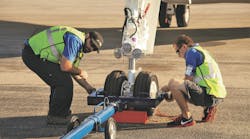Safety Spotlight - Open/Shut Idea
By Mike Mooney, Valley Oil Company LLC
January/ February 2001
A potential problem: manually operated internal valves
I've recently noticed a disturbing practice by some line service technicians: operating aircraft refueler trucks and leaving manually operated internal valves in the open position at all times.
Trucks
of most concern are those with a spring-loaded handle
that manually controls the internal valve and in some
cases doubles as the emergency shutoff. You must pull
this handle out to open the internal valve and allow
fuel to flow from the tank. Push this handle in and
a spring should automatically close the internal valve
and stop the flow of fuel. That is why some of them
are labeled "Emergency Shutoff" and painted
red.
A little thing ...
While visiting an airport
in Florida, the line technician pulled up in the avgas
truck, shut off the engine, set the brake, jumped out,
and went into the office. Walking around the truck,
I noticed the manual internal valve (marked emergency
shutoff) pulled out. Refuelers like this were built
with a 3-1/2 inch wide vent that opens when the internal
is open (see illustration). It rises about one inch,
allowing air to flow out of or into the tank.
A big problem ...
This vent has no rain
or dust hood to protect it from the elements. In a place
like Florida, where 3 inches of rain can fall in minutes,
the tank top drains can easily back up and water will
pool on the top of the truck's tank, much like a backed
up sink. The open vent then acts like a drain, allowing
water to flow directly into the tank and contaminating
the fuel. This can result in water being pumped into
aircraft. Dirt and other debris can also enter the tank
through the open vent.
Even if a refueler truck's
tank vent is air operated and/or protected with a hood,
it's unsafe to leave the internals open all the time.
Remember this valve controls the valve at the bottom
of the tank. When opened, it floods the plumbing with
fuel where it is drawn into the pump, then pushed through
the filter, meter, hose, and nozzle. Leave this valve
open and you remove/override an important safety feature.
For instance, if while driving the truck you run over
a wheel chock, curbing, or other high spot and rupture
the plumbing, without the valve in the closed position
the entire contents of the tank will spill on the ground.
Many avgas trucks are also fitted with vapor recovery
systems. When the vent is left open and the trucks are
full, fuel can splash into the vapor line as the truck
is driven.
Thankfully a majority
of truck designs include an interlock that sets the
brake when the internal valve is opened, so the valve
must be closed before the truck can be moved.







